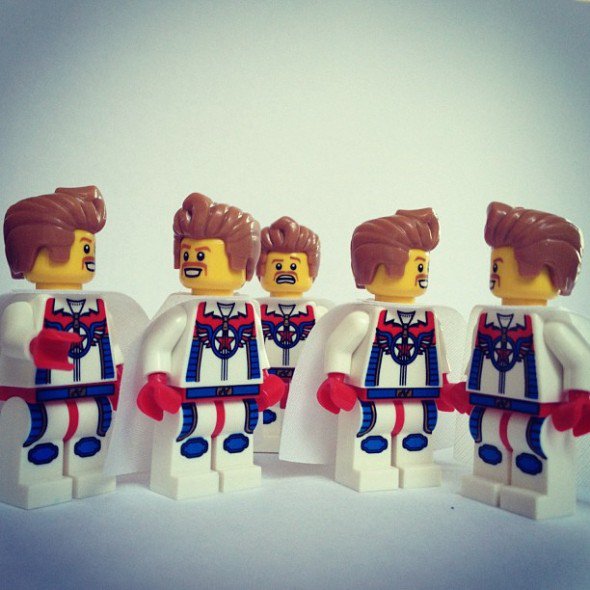
This
post was originally published on
this siteOriginally posted at: http://www.nerdfitness.com/
Confidence. Can it be developed?
It’s one of the most desirable traits when it comes to finding a partner, one of the most desirable traits when it comes to employment, and a hell of a way to make a positive first impression.
I’m sure you can conjure up someone you think of as “confident.”
-
James Bond’s uncanny ability to stay calm, cool, and collected under pressure, and then utter a perfectly timed and witty catchphrase.
-
That female friend of yours who can strike up a conversation with anybody and everybody, making them feel like they’ve found a new best friend within minutes.
-
Your buddy who has quickly advanced through a company, and just seems to have “it.”
Whether you’re young or old, gay or straight, male or female, human or cyborg, confidence will make your life better!
Can confidence be built, or is it outside of our control?
Today, I’m going to teach you everything you need to know about confidence, and how you can quickly implement a few tactics to kickstart your leveling up.
what is confidence?

Before I dig into how to improve your confidence, I want to talk about what it really is.
I’m NOT talking about the guy who focuses on building six-pack abs and big biceps, who attends seduction classes, follows word-for-word scripts and approach techniques to hit on people, makes sure to get a pump before walking out the door. This dude often lacks a base level of confidence and self-respect, and is approaching confidence building from the wrong angle; his strategy is a house of cards to cover up a level of insecurity.
Real confidence is about being true to who you are (and being excited about it!). Think of your friend who acts completely differently depending on who she might be trying to impress, even if the person they’re pretending to be doesn’t line up with who they really are (or want to be).
The late Mitch Hedberg said it best: “If you stand in the meat section at the grocery store long enough, you start to get mad at turkeys. There’s turkey ham, turkey bologna, turkey pastrami. Someone needs to tell the turkey, ‘man, just be yourself.’”
So, we want to practice the type of confidence that is built around knowing who you are as a person and understanding what’s important – like Ron Swanson in Parks and Recreation, one of the greatest characters on one of the best shows out there.
Ron is known for the hilariously awesome credo and code that he lives by:
This pyramid guides his decision making process, even if some of it is unpopular or “uncool.” Tom Haverford on Parks and Rec, on the other hand is the antithesis of this.
He’s chasing tactics to be ‘confident’ but for the wrong reasons:
Ron’s quiet confidence and steadfast conviction to who he is as a person makes him great, and why the racoon hat works for him when it failed as a tactic for Tom.
In the Nerd Fitness Rebellion, this is the type of confidence we seek: not necessarily changing who we are to impress people, but rather staying true to who we are as we level up our lives. We are all works in progress, but we also need to have self-respect: that we are worthy as partners, friends, co-workers, and people. We accept where we’re at currently, but we work every day on self-improvement.
As Henry Rollins says: “I have never met a truly strong person who didn’t have self-respect.”
So, while we level up, we can use the tactics in this article to enhance ourselves and make sure we are presenting our best possible selves to the real world. I want you to think about the type of confidence you’re trying to develop, even if you don’t have it quite yet:
The quiet confidence of somebody who commands respect?
The boisterous person that walks in the room and instantly everybody wants to become best friends with?
The lovable goofball that doesn’t take herself too seriously?
Once we know the type of person we’re working towards becoming, we can apply the information below to help us level up until we reach that goal.
Stand up straight, get big, Move confidently!

Did you know that sitting a certain way for just a few minutes before a date or interview can greatly boost your chances of success in the encounter?
How crazy is that!? Seriously. Just by changing your posture you can physiologically develop more confidence within minutes. That’s right. Not just “appear” more confident, but actually BE more confident, based on how you are standing or sitting.
That’s like a free power-up!
How we are treated and how how we treat ourselves is mostly dependent on our non-verbal communication – how we stand, how we walk, how we look, and so on. Once we understand these things, we can hack our body language to improve our confidence subconsciously.
As Amy Cuddy points out in her TED Talk, our bodies can literally change our minds:
What Amy is saying: if you are trying to become more confident instantly, adopting a power pose for just a few seconds can change how you feel and act.
By adopting a power pose before entering a tense situation, you will subconsciously adjust how your brain responds. As the aforementioned study points out:
“High-power posers experienced elevations in testosterone, decreases in cortisol, and increased feelings of power and tolerance for risk; low-power posers exhibited the opposite pattern.
In short, posing in displays of power caused advantaged and adaptive psychological, physiological, and behavioral changes.”
Another study in the European Journal of Psychology examined people’s self-confidence based on posture:
The applicants who were slumped over had lower self-confidence, as expressed by their answers, than those who sat up straight. This research shows that whether you sit up straight at your desk or slump in your chair impacts the chemicals produced in your brain, which, in turn, affect what goes on in your mind.
So how do we use this to our advantage? Before you enter any situation when you need confidence and courage (going out to a bar, asking for a raise, asking somebody out over the phone)…adapt a power pose for a few moments beforehand!
Here are some examples of power poses that you can use throughout the night, before you go out, and when you want to openly display your confidence:
- Hands raised above head in victory pose
- Hands on hips like Superman or Wonder Woman
- Legs crossed, hands behind head
- Sprawled out across a seat
Strike these poses and set yourself up to succeed. Practice in a stairwell, in your cubicle, in a bathroom stall, or while looking in a mirror; just do it whenever you need a quick burst of confidence before entering the challenging situation.
take pride in your appearance

In addition to how we stand and walk, how we dress can drastically influence our levels of confidence as well.
Yup. How you dress can ACTUALLY boost how confident you are, in addition to how people will treat you (which in turn then affects your confidence even further!)
Two things happen when you wear clothes that present you in the best possible light:
- You treat yourself differently, and become more confident in the right clothing.
- You will be treated differently by people. Jaywalk while wearing a suit, for example, and people will be 350% more likely to follow you than if you wore a t-shirt.
So, by putting on the right kind (or properly fitting clothing), we can change how we view ourselves, in addition to how others view us: setting us up doubly for a confidence super boost.
As pointed out in a recent New York Times article, studies have shown that you can trick your brain based on what you are wearing, which is referred to as “enclothed cognition.” When you dress in a certain way, you can trick your brain into changing how you react to certain situations, or adjust how much confidence you have.
What about how other people treat you? I can hear you thinking (I have superpowers): “I just wear what’s comfortable, and if people judge me for it, that’s their problem.” We’ve all said the above when we’ve been treated in a way we’re not happy about, or when somebody didn’t take the time to get to know us. As nerds, it’s like it’s built into our DNA: “how dare that person not respect me for me, regardless of my appearance.”
The truth: 99.9999% of people will never get to know the real you. They can only go off what they see and subconsciously process that about you within fractions of a second. So, being more confident starts by dressing the part, and how you dress can affect the outcome of an interaction:
“Experiments have shown that women who dress in a masculine fashion during a job interview are more likely to be hired, and a teaching assistant who wears formal clothes is perceived as more intelligent than one who dresses more casually.”
So how does one start to dress better, to get both benefits of changing how you view yourself and how others view you? Guys – if you’ve ever worn a perfectly tailored suit for a wedding, or ladies, a dress that made you feel like a superstar, you know what I mean.
Depending on your style, that might be dressing like a musician, or in a suit, or in jeans and a tee shirt – it comes down to fit and how good YOU feel in those clothes! After all:
“What about suits and ties? “If you associate those clothes with power and confidence, it’s going to have a huge impact [on subconsciously making you act more powerful and confident],” he says. “But for some people, wearing suits makes them feel like a phony, as Holden Caulfield would say. So it’s really about what the symbolic meaning of the clothes is to the person.”
So, it all comes back to YOU being YOU, and dressing in a way that accentuates that. Dress the part for the type of confidence you WANT to exude, and your body will respond in kind.
Making a Great First Impression

Okay! We’ve prepared, but now we’re going out into the wild!
Social interaction can be a HUGE challenge for many, and even the most confident looking person can fall apart as soon as they encounter another human. So how can we set ourselves up to win before we even start to speak?
Here are the two most important tips, backed by science, that will make you appear more confident and can help you on dates, interviews, or any other social interaction:
1) Smile, fool! People will respond to the emotions you project. If you are projecting “I am happy and fun,” they will subconsciously want to be happy too. The best way to trick your brain into being happy and fun is to start with a smile. As this study and this study point out, smiling can make you happier, and change how you think and feel about yourself.
2) Eye contact. This is challenging, as it makes most people feel incredibly awkward. Do you walk around looking down at the ground, avoiding eye contact with others? Or if you happen to lock eyes with somebody, do you quickly look away? Most of us do these things automatically, and it screams “I am insecure.” As you’re developing confidence, really focus on maintaining eye contact with people, as it can certainly affect how you are treated.
As Art of Manliness points out in this article on Eye Contact: “Numerous studies have shown that people who make higher-levels of eye contact with others are perceived as being:
- More dominant and powerful
- More warm and personable
- More attractive and likeable
- More qualified, skilled, competent, and valuable
- More trustworthy, honest, and sincere
- More confident and emotionally stable
If you’re on a date or having an intense conversation with a boss, maintaining eye contact is a huge part of exuding strength, confidence, and self-respect.”
Try it today. While walking down the street, maintain eye contact with strangers as you walk by them. If they look at you, despite everything in your brain telling you to turn away, maintain your gaze! Try a smile, a brief head nod, and continue on your way.
Also, don’t forget to blink. You’re welcome 
Fake it ’til you become it.

Along with everything above, there’s one last thing we can to do build confidence: Fake it!
There are many different kinds of confidence – think about the characters or people that you admire or people you respect and would like to emulate. Start by identifying the person you’d like to be more like, and emulate them.
As Derek Halpern, founder of Social Triggers, explains in this following video, ask yourself “how would a confident person act in this situation?” And then, act how that person would act.
It’s okay if it feels weird or it’s not how you would normally act – you’re acting. Like a scientist testing a hypothesis, you’re merely trying things out. This can help remove a lot of the fear of rejection or awkward situations:
Derek is a friend of mine, and I’ve witnessed him take over a room in New York City within five minutes simply through his actions, mannerisms, and voice; it was hilarious and inspiring. After he did this in multiple locations within an hour, I knew he had the code cracked…but I also know from our conversations that Derek wasn’t born confident – it was a skill he actively built and worked on over the years to improve.
I realize this might sound counterintuitive to what I’ve been explaining: how can faking it improve ACTUAL confidence (aka the true confidence we seek)? Just as how we stand or dress can physiologically change our brains, adopting certain “confident” traits can also physiologically change our brains – allowing us to exude the very confidence we’re trying to build! Just remember we are embodying and emulating the positive traits of the confident and charismatic people, and using those things to present our best selves.
I want you to try the following TODAY:
1) Wear clothes today that you feel DAMN good in, that fit your body type.
2) Before you head out in the wild, strike a power pose for 2 minutes.
3) When you walk, do so tall and proudly.
4) The next stranger you see (or coffee shop barista, waitress, receptionist, whoever), work on maintaining eye contact while smiling.
And then report back on how you were treated or how people responded compared to how you are normally treated! Did you carry yourself differently? If you who used to be shy and have actively improved your social confidence, do you have any tips for your fellow socially awkward Rebels?
-Steve
PS: Almost 2,000 Rebels joined Nerd Fitness Yoga last week, and it’s been awesome seeing so many people get started with yoga for the first time. If you missed out, take the free flexibility challenge and we’ll be opening doors again later on in 2015!
###
photo source: walking on air: ryan claussen, Danbo’s Life: Carlo Ciccarelli, personality: vic








 This
This 

 This
This 





 For now classes are 6pm and 640pm at 2840 Wildwood st in the Boise Cloggers studio.
Book your class NOW!
click this ==>
For now classes are 6pm and 640pm at 2840 Wildwood st in the Boise Cloggers studio.
Book your class NOW!
click this ==>








